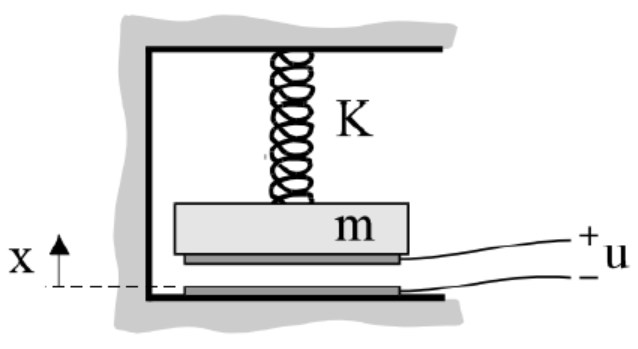A group of scientists studying gravitational waves discover that their detector is influenced by vibrations in the Earth in the area around their setup. The solution to this problem is to measure these vibrations as well and use the results to compensate the gravitational wave measurements. They start designing an accelerometer that could be sufficiently sensitive to measure the vibrations. One constraint is that the accelerometer has to be very small and can be battery operated, since in the end they will need hundreds of these accelerometers distributed over an area of several hundred square meters around their setup.
They start with a basic structure as indicated below. The mass m has to be very small, so the spring constant K also has to be small in order to have sufficient sensitivity. They will use a capacitive readout because of the much lower power consumption and higher sensitivity compared to strain gauges.
In order to measure the changes in capacitance they will have to apply a voltage between the two electrodes. They know that this will also introduce an electrostatic force so that the distance between the electrodes will decrease. In fact, this could make the measurement more sensitive because the capacitance value will increase. Is this correct? How far could the distance between the electrodes be reduced in this way?
After doing some experiments, the scientists find that not only does the distance between the electrodes decrease with the applied voltage, but much to their surprise also the resonance frequency of the entire device changes as if the mass or spring constant is changing as a function of voltage. Can you explain this? Can you derive an expression for the resonance frequency as a function of the applied voltage? Could this effect also be used to increase the sensitivity of the accelerometer?
After some thought they conclude that maybe they can use the resonance frequency as the output signal for the accelerometer: an acceleration will change the position of the mass, which will change the electrostatic force due to the voltage, which in turn will change the resonance frequency of the device. Would a system like this be possible? Could the resonance frequency be detected by e.g. measuring the electrical impedance seen by the voltage source?
